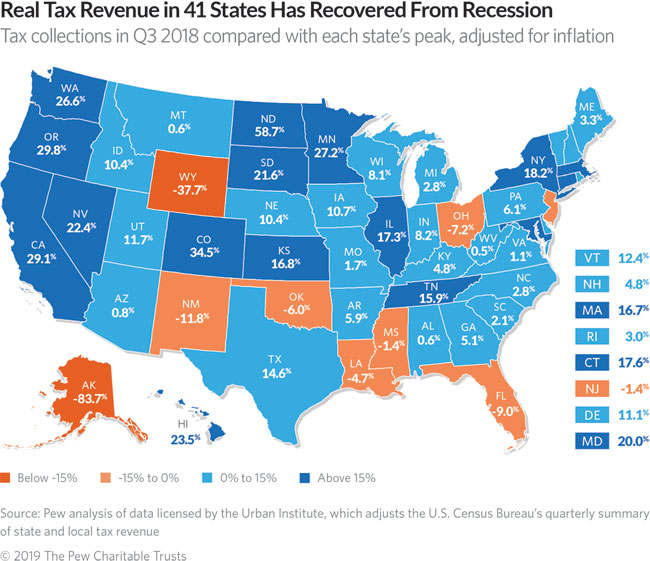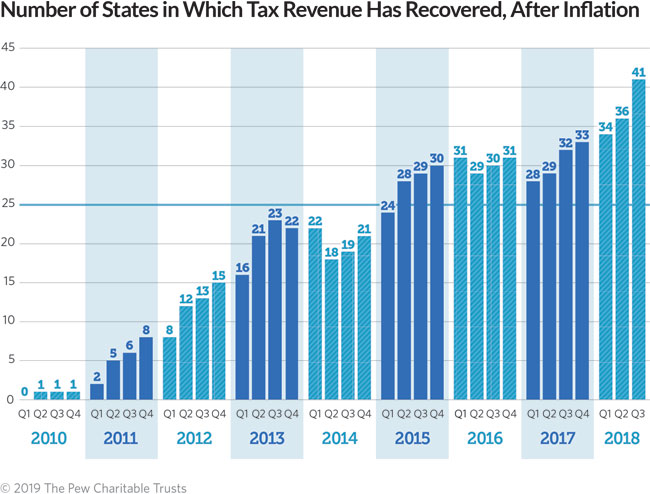States Add to String of Tax Revenue Gains
Note: These data have been updated. To see the most recent data and analysis, visit Fiscal 50.
Tax revenue rose in all but five states in the third quarter of 2018, lifting the number of states in which collections had fully recovered from the Great Recession to a record-high 41, after accounting for inflation. The widespread increases extended one of the strongest stretches of growth since the downturn, though the surge showed signs of fading.
State tax revenue turned a corner in late 2017 after the weakest two years of growth—outside of a recession—in at least 30 years. As most states entered the 2019 budget year in July, a fourth consecutive quarter of solid gains pushed total state tax collections to 13.4 percent above the peak recorded in 2008, after adjusting for inflation.
The results mean that states collectively had the equivalent of 13.4 cents more in purchasing power for every $1 they collected at their recession-era peak a decade earlier, after adjusting for inflation and averaging across four quarters to smooth seasonal fluctuations.
Revenue collections have been boosted in part by the 2017 federal Tax Cuts and Jobs Act—which changed what many individuals and businesses owed to state tax collectors—and by favorable economic conditions, robust stock market returns in late 2017 through much of 2018, and state policy actions.
But the 2017 revisions to the U.S. tax law introduced uncertainty into state collections trends as both states and taxpayers adjusted to the federal changes. The result is that some of states’ recent tax revenue gains could be short-lived. Preliminary figures for the final quarter of 2018, in fact, showed growth softening.
Links between state and federal tax codes automatically increased what many individuals and businesses owed to states’ tax collectors, unless states acted to neutralize the effects. At least a dozen states altered their personal income tax laws in 2018 to return portions of their windfall to individual taxpayers, and more states were expected to consider rolling back some of the gains. The federal law also incentivized taxpayers to shift the timing of income and payments in ways that may have resulted in another temporary inflation of state tax collections. Gains in some states also came from a deadline for hedge fund managers to pay taxes on offshore earnings by the end of 2017.
Just nine states collected less in inflation-adjusted tax dollars than at their peak before collections plunged in the recession. Revenue in these states was still below its recession-era peak for a variety of reasons, including tax cuts, weak economic growth, volatile energy prices, or an unusually high tax revenue peak before the downturn.
But even states that have surpassed their recession-era peaks had to deal with years of slow revenue growth before the recent spike, leaving governments with little extra to cover costs associated with population increases, growth in Medicaid expenses, deferred needs, and accumulated debts and liabilities.
Total state tax revenue rebounded more slowly after the 2007-09 recession than it did after any of the three previous downturns. But trends have varied widely by state. In 16 of the 41 states in which collections had recovered from their recession losses by the third quarter of 2018, tax revenue—and thus purchasing power—was more than 15 percent higher than at its peak before or during the recession. Conversely, collections were down 15 percent or more in two of the nine states in which tax revenue was still below peak.
As states regain fiscal ground lost in the recession, policymakers face pressure to catch up on investments and spending postponed because of the downturn. That may be more difficult in states where tax revenue remains below its previous peak.
State highlights
A comparison of tax receipts in the third quarter of 2018 with each state’s peak quarter of revenue before the end of the recession, averaged across four quarters and adjusted for inflation, shows:
- North Dakota remained the leader among all states in tax revenue growth since the recession, although its collections have swung dramatically along with the price of oil during the same period. At the end of 2014, receipts hit a high of 123.9 percent above their peak during the recession, compared with 58.7 percent above in the third quarter of 2018.
- Fifteen other states posted tax revenue rebounds of 15 percent or more: Colorado (34.5 percent), Oregon (29.8), California (29.1), Minnesota (27.2), Washington (26.6), Hawaii (23.5), Nevada (22.4), South Dakota (21.6), Maryland (20.0), New York (18.2), Connecticut (17.6), Illinois (17.3), Kansas (16.8), Massachusetts (16.7), and Tennessee (15.9).
- Alaska (-83.7 percent) was furthest below its peak. This means the state collected only about 16 percent as much in inflation-adjusted tax dollars as it did at its short-lived peak in 2008, when a new state oil tax coincided with record-high crude prices. Without personal income or general sales taxes, Alaska is highly dependent on oil-related severance tax revenue, which began falling even before worldwide crude prices declined in 2014 as its oil production waned.
- One additional state was down more than 15 percent from its previous peak: Wyoming (-37.7 percent).
- Other states still below their peaks were New Jersey (-1.4 percent), Mississippi (-1.4), Louisiana (-4.7), Oklahoma (-6.0), Ohio (-7.2), Florida (-9.0), and New Mexico (-11.8).
- Three states surpassed their pre-recession peaks for the first time: South Carolina (2.1 percent), Arizona (0.8), and Alabama (0.6).
- The only states where tax revenue fell in the third quarter of 2018 from a year earlier were Hawaii, Idaho, Kentucky, Nevada, and Rhode Island.
Latest trends
Overall tax revenue grew 5.7 percent in the third quarter of 2018 compared with a year earlier, adding to a string of strong quarterly increases, although growth has been slowing since the spike states saw at the end of 2017.
The largest source of total state tax revenue, personal income taxes, was up by 5.5 percent. Collections in the most recent four quarters showed the strongest growth in five years and have driven the bulk of recent gains.
The other major tax revenue source for most state governments—sales taxes—also showed strong growth, increasing by 4 percent, the biggest margin since early 2015. However, growth still trailed rates seen in past economic expansions due in part to consumer spending patterns that have been migrating toward services and online purchases that are less likely to be taxed.
In states with significant fossil fuel production, rising energy prices buoyed tax collections. Oil prices rose steadily since late 2017 following several years of low prices, pushing many energy-reliant states up from recent tax collection lows. (Oil prices fell again, however, later in the calendar year.)
The tax revenue growth that most states enjoyed through the third quarter was expected to moderate further in the fourth quarter, according to preliminary figures collected by the Urban Institute. Several states missed revenue projections at the end of the calendar year amid weaker-than-expected stock market performance.
Future growth is unlikely to be as strong as the temporary effects of the federal tax changes diminish, while economic growth is expected to slow. Stock market volatility along with a global economic slowdown and the impacts of U.S. trade uncertainty will also threaten to dampen tax revenue growth in upcoming quarters.
Trends since the recession
State tax revenue—like the U.S. economy—has grown slowly and unevenly since the recession. Over the past 10 years, the number of states that have regained their tax revenue levels has risen and fallen, reflecting volatility in state tax collections as well as tax policy changes.
Nationally, tax revenue recovered from its losses in mid-2013, after accounting for inflation. But individual state results have differed dramatically depending on economic conditions, population changes, and tax policy choices since the recession. For example, state policymakers have enacted tax cuts in states such as Ohio and North Carolina and hikes in states such as Illinois and Oklahoma since the recession. According to the National Association of State Budget Officers, states enacted $3.1 billion in net tax increases for fiscal 2019 following nearly $10 billion in hikes for the previous year. These increases follow much smaller rises in the previous two fiscal years and net tax cuts of roughly $2 billion in each of fiscal years 2014 and 2015.
In 2010, North Dakota was the first state to surpass its recession-era peak, followed by Vermont, Illinois, New York, and West Virginia by mid-2011. Tax receipts were above peak in 12 states at the end of fiscal 2012; 22 states at the end of fiscal 2013; 18 states at the end of fiscal 2014; 28 states at the end of fiscal 2015; 29 states at the end of fiscal years 2016 and 2017; and 36 states at the end of fiscal 2018, before jumping to 41 states a quarter later.
State budgets do not adjust revenue for inflation, so tax revenue totals in states’ documents will appear higher than or closer to pre-recession totals. Without adjusting for inflation, 50-state tax revenue was 32.8 percent above peak and tax collections had recovered in 48 states—all except Alaska and Wyoming—as of the third quarter of 2018. Unadjusted figures do not take into account changes in the price of goods and services.
Adjusting for inflation is just one way to evaluate state tax revenue growth. Different insights would be gained by tracking revenue relative to population growth or state economic output.
Download the data to see individual state trends from the first quarter of 2006 to the third quarter of 2018. Visit The Pew Charitable Trusts’ interactive resource Fiscal 50: State Trends and Analysis to sort and analyze data for other indicators of state fiscal health.


America’s Overdose Crisis
Sign up for our five-email course explaining the overdose crisis in America, the state of treatment access, and ways to improve care
Sign up










